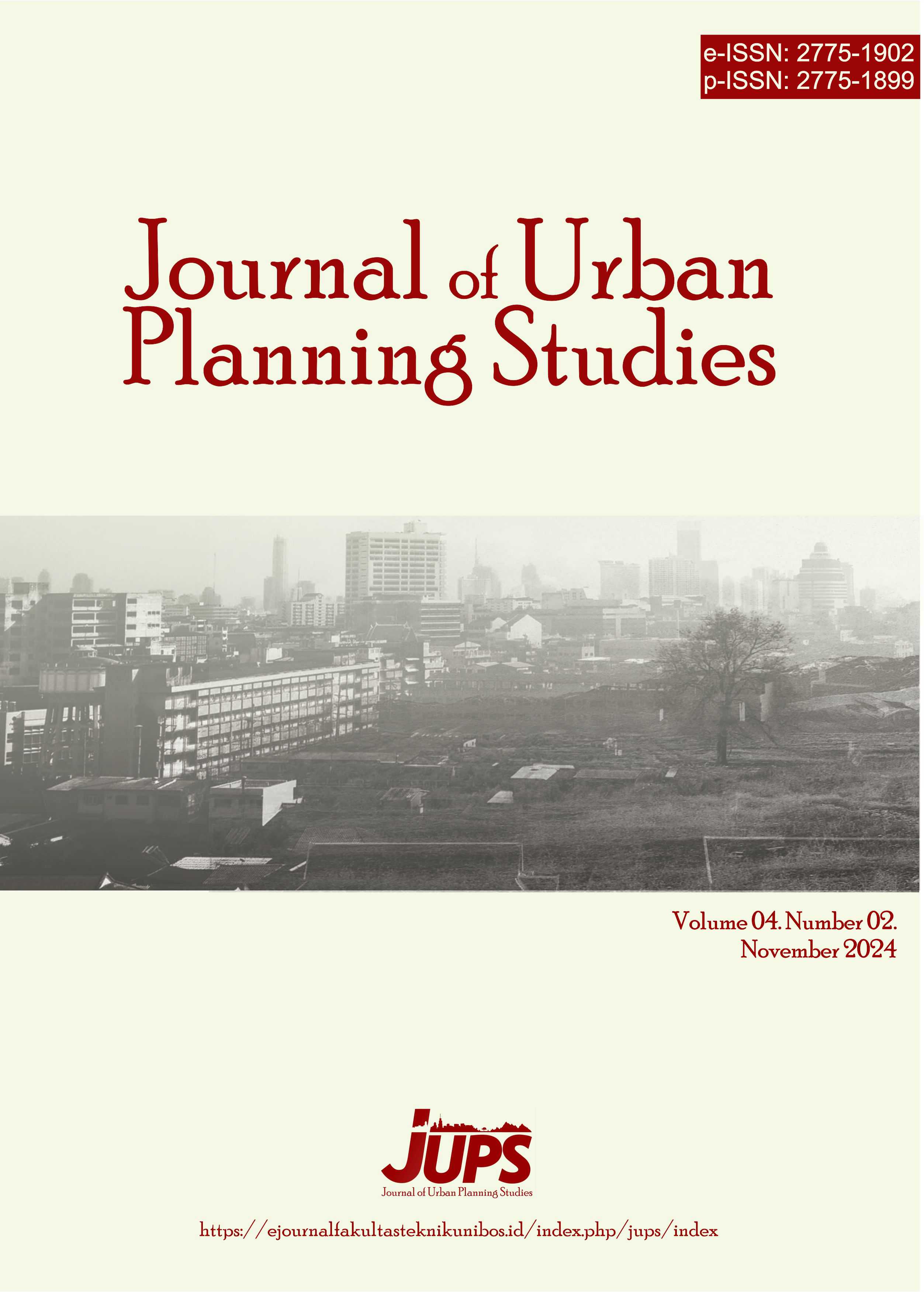Arahan Pengembangan Ruang Terbuka Hijau di Kota Makale Kabupaten Tana Toraja
Studi Kasus: Kelurahan Bombongan
DOI:
https://doi.org/10.35965/jups.v4i2.470Kata Kunci:
Ruang Terbuka Hijau, Perkotaan Makale, Kelurahan BombonganAbstrak
Abstract.The goal of this study is to examine the major causes impacting the absence of green open space in Makale City and to suggest strategies for the development of green open space in Makale City. This research technique is a quantitative-methods. The Chi-Square analysis tool was used to assess the key elements impacting the shortage of green open space in Makale City, while descriptive qualitative analysis was utilized to generate suggestions for the development of green open space in Makale City. The fundamental conclusion of this study is that, based on the Chi-Square results, the element of land availability has a substantial effect on the absence of variable Y or Green Open Space (RTH). Meanwhile, education is a crucial element influencing the absence of Green Open Space (RTH). The Regional Government as the manager of Green Open Spaces in Makale City, issuing regional regulations or planning documents related to the utilization of regional Green Open Spaces in Tana Toraja Regency, and the Regional Government as the person in charge of providing Green Open Spaces (RTH) in urban areas are the directions for the development of green open spaces in Makale City. Makale Kelurahan Bombongan immediately resolves problems related to inadequate land in Makale City and increases the number of green open spaces to meet the minimum quota of green areas, and re-evaluates green open spaces (RTH) in Makale urban areas with reference to the relevant regulations.
Abstrak. Tujuan dari penelitian ini ialah untuk menganalisis faktor signifikan mempengaruhi kurangnya ruang terbuka hijau di Perkotaan Makale dan merumuskan arahan pengembangan ruang terbuka hijau di Perkotaan Makale. Pendekatan penelitian ini merupakan penelitian kuantitatif. Untuk menganalisis faktor signifikan mempengaruhi kurangnya ruang terbuka hijau di Perkotaan Makale menggunakan alat analisis Chi-Square sedangkan untuk merumuskan arahan pengembangan ruang terbuka hijau di Perkotaan Makale menggunakan analisis deskriptif kualitatif. Kesimpulan utama dalam penelitian ini yaitu berdasarkan hasil Chi-Square, faktor yang signifikan mempengaruhi kurangnya variabel Y atau Ruang Terbuka Hijau (RTH) yang pengaruhnya kuat adalah aspek ketersediaan lahan. Sedangkan yang berpengaruh sangat lemah terhadap faktor yang signifikan mempengaruhi kurangnya Ruang Terbuka Hijau (RTH) adalah aspek pendidikan. Adapun arahan pengembangan ruang terbuka hijau di Perkotaan Makale yaitu Pemerintah Daerah sebagai pengelola Ruang Terbuka Hijau diperkotaan Makale, menerbitkan peraturan daerah ataupun dokumen perencanaan terkait dengan pemanfaatan Ruang Terbuka Hijau daerah Kabupaten Tana Toraja dan Pemerintah daerah sebagai penanggung jawab penyediaan Ruang Terbuka Hijau (RTH) di Perkotaan Makale segera menyelesaikan permasalahan terkait lahan yang sudah tidak memadai di Perkotaan Makale dan menambah jumlah lahan Ruang Terbuka hijau untuk memenuhi kouta minimal lahan hijau, serta mengevaluasi kembali Ruang Terbuka Hijau (RTH) diperkotaan Makale dengan mengacu kepada aturan-aturan yang terkait.
Referensi
Arikunto, S. (2006). Prosedur Penelitian Suatu Pendekatan Praktik. Rineka Cipta.
Hair, J. F. (Ed.). (2006). Multivariate data analysis (6th ed). Pearson Prentice Hall.
Kementrian Agraria dan Tata Ruang/Badan Pertanahan Nasional. (2022). tentang Penyediaan dan Pemanfaatan Ruang Terbuka Hijau (No.14 Tahun 2022). Sekretariat Negara: Indonesia
Koentjaraningrat. (1997). Metode-metode penelitian masyarakat (11 ed.). Gramedia Pustaka Utama.
Latief, R., Hidayat, Y. T., & Yahya, I. (2021). Analisis Perubahan Pemanfaatan Ruang Terbuka Hijau di Kecamatan Mandai Kabupaten Maros. Journal of Urban Planning Studies, 2(1), 43-54.
Nazir, M. (1988). Metode Penelitian. Ghalia Indonesia.
.Tika, Moh Pabundu. (2005). Metode Penelitian Geografi.Jakarta: Bumi Aksara.
Santoso, B., Hidayah, R., & Sumardjito. (2012). Pola Pemanfaatan Ruang Terbuka Hijau Pada Kawasan Perkampungan Plemburan Tegal,Ngaglik Sleman. Inersia Lnformasi Dan Ekspose Hasil Riset Teknik Sipil Dan Arsitektur, 8(1), Article 1. https://doi.org/10.21831/inersia.v8i1.3694
Sarwono, J. 2006. Metode Penelitian Kuantitatif dan Kualitiatif. Graha Ilmu. Yogyakarta.
Sugiyono. 2007. Metode Penelitian Kuantitatif Kualitatif dan R&D. Bandung: Alfabeta.
Sugiyono. (2016). Metode Penelitian Kuantitatif, Kualitatif, dan R&D (23 ed.). Penerbit Alfabeta.
##submission.downloads##
Diterbitkan
Cara Mengutip
Terbitan
Bagian
Lisensi
Hak Cipta (c) 2024 Gebryl Requelmy Tulung Allo, Syafri, Rusneni Ruslan

Artikel ini berlisensi Creative Commons Attribution 4.0 International License.













